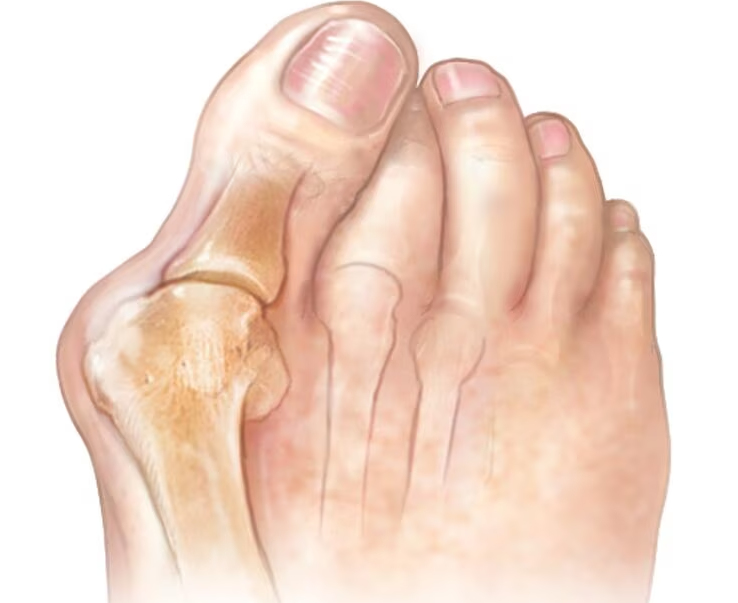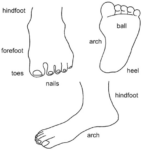Toe pain refers to discomfort or pain experienced in one or more toes of the foot. It can vary in intensity and may be caused by a range of factors. Gout, a type of arthritis, has the potential to induce toe pain. It occurs when crystals accumulate within the joints of the toes, resulting in intense pain and pronounced swelling. Frequently, it predominantly affects the big toe.
Common causes of toe pain include:
- Ingrown Toenails: When the edge of a toenail grows into the surrounding skin, it can cause pain, redness, and inflammation in the affected toe.
- Corns and Calluses: These are areas of thickened skin that can develop on or between the toes, causing localized pain or discomfort.
- Toe Fractures: Injuries or trauma to the toes can result in fractures, leading to pain, swelling, and bruising in the affected toe.
- Gout: Gout is a type of arthritis caused by the buildup of uric acid crystals in the joints, and it often affects the big toe, causing severe pain and inflammation.
- Bunions: Bunions, which are bony bumps at the base of the big toe, can lead to pain in the big toe and even the adjacent toes as they become misaligned.
- Hammertoes: Hammertoes are deformities that cause the toes to bend or curl downward, leading to pain and discomfort.
- Ingrown Toenails: When the edge of a toenail grows into the surrounding skin, it can cause pain, redness, and inflammation in the affected toe.
- Arthritis: Various forms of arthritis, such as osteoarthritis and rheumatoid arthritis, can cause joint pain and inflammation in the toes.
- Toe Tendonitis: Inflammation of the tendons in the toes can result in pain, especially when moving the toes.
- Neuropathy: Nerve damage or compression of the nerves that supply the toes can lead to burning, tingling, or shooting pain in one or more toes.
- Infections: Fungal infections, bacterial infections, or cellulitis can cause pain and discomfort in the toes.
- Injuries: Accidents or overuse can lead to strains, sprains, and other traumatic injuries that cause toe pain.
- Tight Footwear: Wearing shoes that are too tight or narrow can compress the toes, leading to pain and discomfort.
The specific type of toe pain and its underlying cause will determine the appropriate treatment and management.

How Many Kinds of Toe Pains Are there and How to Treat Them ?
Toe pain can have various causes, and the treatment approach depends on the underlying condition or injury. Here are some common types of toe pain and how to treat them:
- Ingrown Toenails: An ingrown toenail occurs when the skin on one or both sides of a toenail grows over the nail. This condition can be painful and has the potential to lead to infections if not properly treated.
- Cause: Ingrown toenails occur when the edge of a toenail grows into the surrounding skin, leading to pain, redness, and inflammation.
- Treatment:
- Soak the foot in warm, soapy water to soften the nail.
- Gently lift the ingrown edge with a clean, sterile instrument.
- Place a small piece of cotton or dental floss under the lifted nail to encourage it to grow above the skin.
- Avoid wearing tight or narrow shoes that put pressure on the toe.
- If the ingrown nail is severe or recurrent, consult a healthcare professional, who may recommend a minor surgical procedure to remove the ingrown portion.
- Corns and Calluses: Corns and calluses are common foot conditions caused by the buildup of tough, thickened skin in response to irritation or pressure. Both corns and calluses can be painful and uncomfortable. Corns: These are concentrated, small, and localized areas of thickened skin that typically develop at points of irritation or pressure on the foot or toe. They can appear as small, round, or conical projections and may sometimes resemble tiny horns. Calluses: Calluses, in contrast, are more extensive areas of thickened skin. They develop as a broader response to continuous irritation or pressure, often found on the toes or the soles of the feet. Calluses have a larger, flattened appearance.
- Cause: Corns and calluses are areas of thickened skin that develop due to repeated friction or pressure.
- Treatment:
- Over-the-counter corn pads and callus files can help remove dead skin.
- Wearing cushioned insoles can reduce pressure and friction on the affected area.
- Address the root cause of friction, such as ill-fitting shoes.
- Consult a healthcare professional if the corn or callus is painful or if you have diabetes or circulation problems.
- Toe Fractures: A toe fracture, which is a broken bone, can occur in any of the bones of the toes. Minor fractures might be managed with rest, ice, and over-the-counter pain relievers. In cases of serious fractures, surgery may be necessary. It’s advisable to consult a doctor for a proper evaluation to determine the extent of the injury.
- Cause: Trauma or injury to the toe can lead to fractures, resulting in pain, swelling, and bruising.
- Treatment:
- Rest the affected toe by avoiding putting weight on it.
- Ice the area to reduce swelling.
- Buddy taping: Tape the fractured toe to an adjacent healthy toe to provide support and prevent movement.
- Consult a healthcare professional for an X-ray to determine the extent of the fracture.
- In some cases, a fractured toe may require realignment and immobilization with a splint or cast.
- Gout: Gout, a type of arthritis, is known to induce toe pain. This condition results from the accumulation of crystals within the joints of the toes, leading to severe pain and pronounced swelling. Typically, the big toe is frequently the primary site of affliction.
- Cause: Gout is a type of arthritis caused by the buildup of uric acid crystals in the joints, often affecting the big toe.
- Treatment:
- Medications, such as nonsteroidal anti-inflammatory drugs (NSAIDs), colchicine, or corticosteroids, can help manage acute gout attacks.
- Lifestyle modifications, including dietary changes to reduce purine intake and alcohol consumption.
- Long-term medications, such as allopurinol, to lower uric acid levels.
- Stay hydrated to help flush out excess uric acid.
- Bunions: A bunion is a protruding bony lump that forms on the side of the foot, typically adjacent to the base of the big toe. This condition is linked to a misalignment of the joint at the base of the first toe. Bunions can affect individuals of all ages, with a higher likelihood of occurrence for those who regularly wear poorly fitting or uncomfortable shoes. Additionally, they tend to become more common as people age.
- Cause: Bunions are bony bumps at the base of the big toe that can cause pain, particularly as they become more severe and misaligned.
- Treatment:
- Wear shoes with a wide toe box to reduce pressure on the bunion.
- Orthotic devices or shoe inserts can provide support and alleviate discomfort.
- Consult a healthcare professional, who may recommend surgical correction in severe cases.
- Hammertoes: A hammertoe is a condition in which the second, third, or fourth toe bends at the middle joint, resembling the shape of a hammer. It can develop due to a muscle imbalance but may also be triggered by wearing shoes that do not fit properly.
- Cause: Hammertoes are toe deformities in which the toes bend or curl downward, leading to pain and discomfort.
- Treatment:
- Wearing shoes with a roomy toe box can reduce pressure on the toes.
- Orthotics or custom shoe inserts can help correct alignment.
- Consult a healthcare professional if the deformity is painful or progressive, as surgery may be necessary.
- Toe Tendonitis:
- Cause: Inflammation of the tendons in the toes can cause pain, especially during movement.
- Treatment:
- Rest the affected toe to allow it to heal.
- Ice the area to reduce inflammation.
- Anti-inflammatory medications or corticosteroid injections may help.
- Physical therapy can be beneficial for strengthening the affected area.
8. Sesamoid Fracture : A sesamoid fracture is characterized by the fracturing of the small bones known as sesamoids, which are located within the tendons connected to the big toe. The primary symptom associated with this condition is pain in the region surrounding the big toe.
- Treatment:
- Rest, apply ice, and elevate your foot.
- Utilize shoes with firm soles or foot cushions to alleviate pressure.
- Consider taking pain relievers.
- If pain persists, consult your healthcare provider for further guidance.
- Treatment:
Turf toe refers to a condition where you experience pain at the base of the big toe. It’s a type of sprain that occurs when you overextend the toe beyond its typical range of motion, resulting in immediate pain and swelling.
Toe sprains, on the other hand, can happen when you jam, stub, or overextend any of your toes, which can damage the tendons or soft tissues of the toe. If there is no fracture involved, the pain and swelling should subside within a few days.
Pain Medications, Pain Relief, and Pain Management
